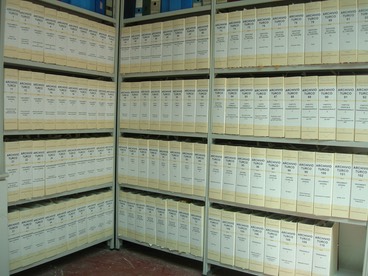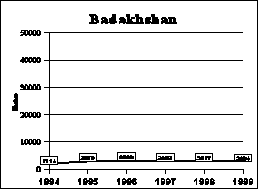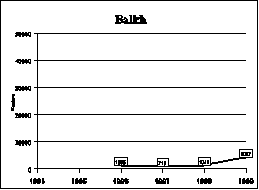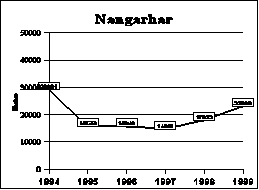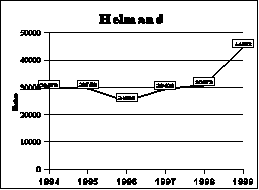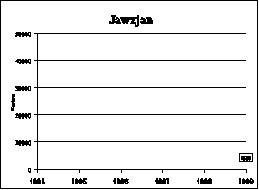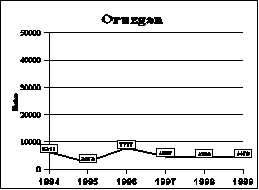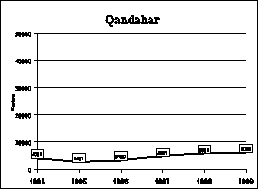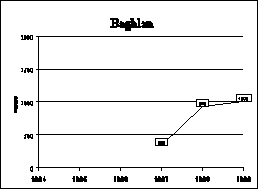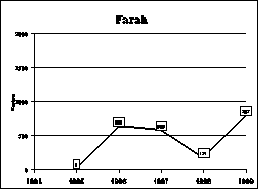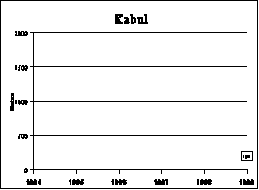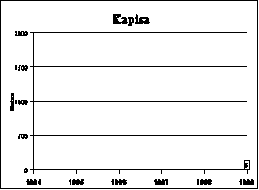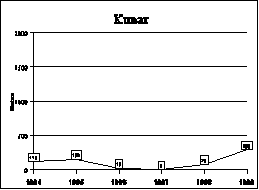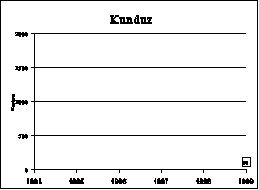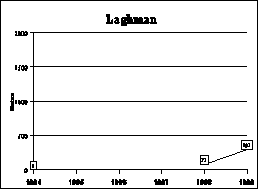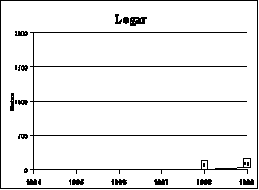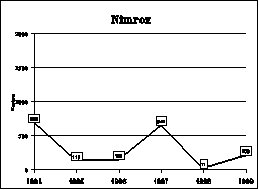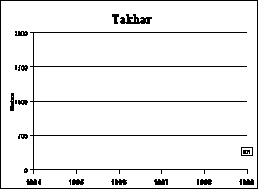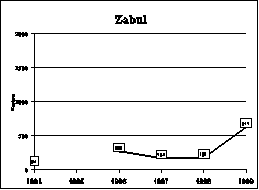Afghanistan Opium Poppy Survey 1999
Contents Page Number
EXECUTIVE SUMMARY i
A. INTRODUCTION 1
1. Justification of the Survey 1
2. The Survey Objectives 1
3. The Survey Methodology 2
4. The Implementation of the Survey in 1999 3
B. RESULTS 8
1. The Provinces and Districts Under Opium poppy Cultivation in 1998/99 8
2. Estimated Opium Production and Yield in 1998/99 11
C. CONCLUSION 12
ANNEXES
Annex A: Figures 15
Annex B: Statistics 19
Annex C: Methodology & Implementation 24
Annex D: Survey Questionnaire 30
Annex E: The Varieties of Opium Poppy Cultivated in Selected Districts 32
EXECUTIVE SUMMARY
The Context
Experience from South West and South East Asia, as well as Latin America, suggests that illicit drug crops tend to be cultivated in areas of political and military conflict. The Upper Huallaga Valley in Peru, the Chapare, Bolivia, and the border areas of Laos, Vietnam and Myanmar all represent areas of ethnic, social and economic unrest. The limited on-farm, off-farm and non-farm income opportunities in these areas has been exacerbated by the absence of formal governance and the rule of law, further constraining public and private investment in social, financial, physical, human and natural capital. These conditions have created the environment for social exclusion, the infringement of human rights and the promotion of illegal activities.
Within this context Afghanistan provides the ideal environment for illicit drug crop cultivation. Twenty years of war has not only taken its toll on the economy but on the social and cultural fabric of civil society. Moreover, the continuing economic and political uncertainty in Afghanistan has constrained the development of longer term livelihood strategies based on agricultural diversification and non-farm income opportunities. As such, opium poppy cultivation has become an integral part of livelihood strategies in rural Afghanistan, providing access to land,(1) labour and credit(2) as well as providing an important source of off-farm income for those with insufficient land to satisfy household basic needs.(3)
The 1999 Survey
In 1999 the Survey was conducted in 106 districts in 18 of the 31 provinces in Afghanistan. Of these only two districts were found to be opium poppy free. The Surveywas conducted by 122 staff who undertook fieldwork in remote, and sometimes inhospitable, areas of Afghanistan for a period of three months. Despite the on-going conflict in Afghanistan, the survey team successfully completed the fieldwork in all but one of the districts in which opium poppy was reported in 1999.
Due to restrictions on the mobility of international staff, the Survey was monitored by 4 national staff members seconded from the UNDCP Afghanistan Pilot programme. Some of these staff had worked on the Survey since 1994, and all were familiar with its methodology due to the logistical and operational support they had provided the Surveyduring its implementation in 1997 and 1998.
The continued support from the Drug Control and Coordination Units (DCCUs) in the provinces of Nangarhar and Qandahar ensured that the Survey team obtained access to all the opium growing districts in which opium poppy was reported in the eastern, southern and western regions of Afghanistan in the 1998/99 growing season. The inclusion of DCCU staff during implementation also facilitated joint ownership over the final results of the Survey.
The Results
- Cultivation: During the 1998/99 growing season an estimated 90,983 hectares of opium poppy were cultivated in Afghanistan. This unprecedented level of opium poppy cultivation represents an increase of approximately 43% from the 1997/98 season. Analysis suggests that the estimated increase in opium poppy cultivation in Helmand province alone accounted for 51% of the total increase in opium poppy cultivation in 1999, whilst the estimated 5,168 hectare increase in opium poppy cultivation in Nangarhar province in 1999 represented approximately 19% of the total increase. The 27 districts in which opium poppy had not been reported prior to 1999 accounted for a further 12% of the 27,309 hectare increase in opium poppy cultivation in 1999. The residual proportion of the increase was derived from the increase in opium poppy cultivation recorded in the remaining opium poppy cultivating provinces. Indeed, according to the Survey, all the provinces except Badakhshan experienced an increase in opium poppy cultivation between 1998 and 1999
- Production: An estimated 4,581 metric tonnes (mt) of opium were produced in Afghanistan in 1999.(4) As opposed to 1998, when considerable crop damage was reported due to unseasonal rains, there were no reports of crop damage in the 1998/99 growing season. Moreover, cold nights and warm days during the harvesting season in the eastern and southern regions reportedly provided the appropriate agronomic conditions for improved yields. Using the 1998 deflated figure of 2,102 mt, that incorporated reports of significantly reduced yields in the provinces of Helmand, Qandahar, Oruzgan and Badakhshan, there was an estimated increase in opium production in Afghanistan of approximately 117% between 1998 and 1999. However, using the actual yields for 1998, derived from responses to the 1999 Survey, it is estimated that 2,692 mt of opium were produced in 1998. This would suggest an estimated increase in opium production of 70% between 1998 and 1999.
- Highest Cultivating Provinces: The province of Helmand surpassed previous records, cultivating an estimated 44,552 hectares of opium in 1999. Indeed, fieldwork revealed that the scale of cultivation in the province prompted a considerable increase in the cost of hired labour during the harvesting period.(5)Nangarhar province experienced a 29% increase in opium poppy cultivation between 1998 and 1999, producing an estimated 22,990 hectares of opium poppy in the 1998/99 growing season. As in previous years these two provinces alone accounted for approximately three quarters of the total opium poppy cultivation in Afghanistan. Moreover, whilst opium poppy was found to be cultivated in 18 provinces, the seven major opium producing provinces accounted for 96% of total cultivation.
- Prices: In 1999, fresh opium prices ranged from the equivalent of US$27 per kilogramme in the province of Jawzjan to US$72 per kilogramme in Kunduz province. The estimated value of the total opium production in Afghanistan in 1999, at farmgate prices at harvest time, was approximately US$183 million.
- Territorial Control: Approximately 97% of the total cultivated with opium poppy was under the control of the Taliban at the time of the Survey in 1999. The remainder was under the control of the Northern Alliance.
- Eradication and Local Bans: In the southern province of Qandahar, the local authorities reported eradicating 400 hectares of opium poppy in UNDCP's target districts of Ghorak, Khakrez and Maiwand. Whilst elements of this operation were witnessed by journalists and UN national staff from a number of agencies, restrictions on the mobility of international staff prevented UNDCP verifying the full extent of the eradication. In Badakhshan, reports suggest that the ban imposed on opium in the district of Zebak in 1998 has been maintained and subsequently extended to the districts of Eshkashem and parts of Baharak. Reports of limited eradication were received from the districts of Faizabad and Baharak in Badakhshan, however verification by UNDCP was not possible.
- New Areas Surveyed: The Survey confirmed that opium poppy cultivation was being undertaken in 27 districts in which opium poppy cultivation had not been reported prior to 1999. A further four districts in which opium poppy was verified, but not surveyed, in 1998 were also included in the Survey in 1999. Consequently, in 1999 opium poppy cultivation has been verified and surveyed in a total of 104 districts in Afghanistan, compared to 73 in 1998 and 55 districts in 1994. Whilst small scale opium poppy cultivation was confirmed in one further district in 1999, it was not possible to survey the area due to logistical constraints.
- The 1999/2000 Opium Poppy Growing Season: In 1999, the socio-economic and ecological conditions in Afghanistan were particularly conducive for opium poppy cultivation during the 1998/99 growing season. High opium prices during the planting season in the eastern and southern regions combined with ideal weather conditions during the harvest led to an increase in the cultivation and production of opium poppy cultivation. In the southern region, the combination of high opium prices during the planting season due to the particularly poor harvest in 1998, along with the concomitant shortfall in savings and credit repayments that households experienced, fuelled opium poppy cultivation in Helmand province. However, it is important to recognise that if the exogenous demand factors remain constant, it is probable that there will be a reduction in opium poppy cultivation in 2000. In-depth fieldwork has revealed that itinerant harvesters negotiated substantial increases in their share of the final opium crop in the southern region during the harvest in 1999.(6) Moreover, dry opium prices in the south fell from a pre-harvest rate of US$60 per kilogramme to US$37 per kilogramme during the harvest period, returning to their 1997 price levels. It is expected that the rise in labour costs combined with the fall in the price of dry opium will ultimately have an impact on households' perception of the relative profitability of opium poppy for the 1999/2000 season, leading to a reduction in opium poppy cultivation next year.
- The Way Forward within Common Programming: Through the work of the Afghanistan Pilot programme, UNDCP has furthered its understanding of the motivations and circumstances that influence household drug crop cultivation in Afghanistan.(7) This work highlights the importance of addressing the multi-functional role of opium within the different livelihood strategies of the various primary stakeholders involved in opium poppy cultivation, rather than simply seeking to replace the income generated from drug crop cultivation with legal alternatives. Such an approach requires a process-oriented multi-sectoral strategy that focuses on well targeted interventions that influence the variables that determine drug crop cultivation at the micro level, including the price of opium, access to credit, access to water, access to unpaid family labour, access to shared or cheap labour arrangements, the expected cost of hired labour, access to on-farm and non-farm income opportunities, and the risk of socially or legally punitive measures. To prove most cost-effective, these interventions need to take place within an enabling environment that promotes wider macro-socio-economic, institutional and legal development. These lessons learnt are central to UNDCP's future programme in Afghanistan with regard to the integration of drugs as a cross-cutting issue within the development assistance community in Afghanistan and the wider framework of Common Programming. Indeed, based on the accumulated experience of the Pilot Programme, UNDCP can provide the technical expertise required to facilitate the inclusion of drug control objectives into conventional development projects in Afghanistan.
A. INTRODUCTION
1. Justification of the Survey
The Annual Opium Poppy Survey for Afghanistan serves to update data on the extent, location and trends in opium poppy cultivation in Afghanistan. The Survey forms the basis for strategic planning and resource allocation not only for UNDCP but also for other multilateral, bilateral, non-governmental and national agencies operating in Afghanistan.
With the increased priority given to the drugs issue in Afghanistan under the Common Programming initiative, information on the location and extent of opium poppy cultivation can assist in both (i) determining the type and quantity of development assistance required for opium-producing areas and (ii) monitoring the effectiveness of the assistance given in these areas with respect to its impact on drug control.
In UNDCP's target districts for the Opium Poppy Reduction Project (C28), the Surveyreveals the extent of compliance with the poppy reduction schedules as agreed in the Drug Control Action Plans, which are signed by community representatives and guaranteed by the local authorities.
The Survey also provides a valuable information source for countries in the subregions of south, southwest and central Asia which are confronted with increasing amounts of opiates, originating in Afghanistan, transiting and, increasingly, being consumed within their borders.
2. The Survey Objectives
The immediate objectives
- To obtain data on the extent and location of opium poppy cultivation.
- To monitor the expansion of opium poppy cultivation into new areas.
- To obtain data on opium prices.
The outputs
- The survey methodology reviewed and improved by February 1999.
- A team of 98 surveyors and 20 coordinators trained and equipped to collect appropriate data by July 1999.
- Fieldwork completed in the provinces of: Badakhshan, Baghlan, Balkh, Farah, Helmand, Jawzjan, Kabul, Kapisa, Kunar, Kunduz, Laghman, Logar, Nangarhar, Nimroz, Oruzgan, Qandahar, Takhar and Zabul by August 1999.
- A final report: The Afghanistan Annual Opium Poppy Survey 1999 completed and disseminated by September 1999.
3. The Survey Methodology
3.1. A ground based census survey
UNDCP conducts a ground-based survey in Afghanistan during which surveyors, using maps and village lists, visit all the villages in the districts to be surveyed. The Survey is census based, requiring surveyors and coordinators to visit all the areas in Afghanistan where opium poppy has been reported and record opium yields, farmgate prices and the extent of opium poppy cultivation in each region.
Given that the methodology used is a census and not a sample, it is crucial that all the areas known to be under opium poppy cultivation are surveyed. Minimizing the risk of omission is given utmost priority. At present the risk of omission is minimal due to continuous consultation and dialogue between UNDCP, other UN agencies and NGOs working in Afghanistan. In addition, UNDCP survey staff in the field gather information on opium poppy cultivation from key informants. Where information regarding new areas of opium poppy cultivation is considered reliable and is received in time, a surveyor is sent to verify the report. If logistics and security conditions permit, this new area is included in the list of districts to be surveyed.
Priority has been given to conducting a census-based survey rather than a sample-based survey due to the importance UNDCP gives to furthering its understanding of the extent and nature of opium poppy cultivation in Afghanistan. In particular, the census approach allows UNDCP to identify new areas of opium poppy cultivation both within and outside existing opium poppy growing provinces. This is deemed particularly important given the Taliban's commitment in 1997 to prevent the expansion of opium poppy cultivation to new areas.
In addition, a census based survey allows UNDCP to collect data on opium production across all opium poppy cultivating districts and explore those factors that influence the final opium yield, including varieties, weather conditions and diseases.
3.2. The selection of target areas
The Survey attempts to cover all the villages in those provinces and districts where opium poppy cultivation is reported. Those provinces where there are no reports of opium poppy cultivation are not included in the Survey. Continuous consultation with NGOs, key informants and UN agencies working in Afghanistan allows UNDCP to update its knowledge of new areas of opium poppy cultivation. The 1999 Survey included all those areas where key institutional and individual informants reported opium poppy cultivation was being undertaken. The extent and location of opium poppy cultivation was surveyed in 6,842 villages in 18 provinces, including the 3 provinces in which opium poppy cultivation was verified in 1998 but could not be surveyed due to security constraints.
4. The Implementation of the Survey in 1999
4.1. Lessons learnt from 1998
It is the intention of UNDCP that the methodology and implementation of the Annual Opium Poppy Survey is based on 'best practice'. To ensure the continued integrity of the results a number of lessons learnt from the implementation of the Survey in 1998 were applied in 1999, including:
- To address the shortfall in the monitoring by international staff, caused by ongoing security concerns, a number of national staff were allocated to monitor the Surveyin 1999. These staff were all seconded from other projects within the programme and were all well acquainted with the implementation of the Survey.
- To ensure that the Survey captured all the areas in which opium poppy was reported, communication between Islamabad and the field was improved to allow further surveyors to be recruited and trained for new areas as opium poppy cultivation was discovered.
- To complete the Survey in the four districts in which opium poppy was verified in 1998, but not surveyed due to logistical and security constraints, fieldwork was undertaken in the districts of Kalafgan in Takhar province, Tagab in Kapisa province, Sarobi in Kabul Province, and Asadabad in Kunar province
- To address increasing reports of small scale opium poppy cultivation in the provinces of Jawzjan, Kunduz and Takhar, the Survey was conducted for the first time in selected districts in each of the provinces.
- To assess whether a full survey was required in Herat province a preliminary mission was undertaken to identify whether opium poppy was being cultivated. The mission revealed that opium poppy was not cultivated in Herat province in 1999.
- To cater for the increased number of districts to be surveyed the number of surveyors was increased from 73 to 98.
- To ensure better supervision of the surveyors, the number of provincial survey coordinators was increased from 18 to 20.
- To ensure access to opium poppy growing areas, so that both physical and visual measurements could be undertaken, the Survey was once again conducted with the support of the State High Commission for Drug Control and in close collaboration with the Drug Control and Coordination Units (DCCUs) in Qandahar and Nangarhar. This collaboration once again proved beneficial, allowing UNDCP improved access to opium cultivating districts across the eastern, western and southern regions of Afghanistan.
4.2. New areas of opium poppy cultivation surveyed in 1999
Afghanistan has witnessed an increase in the number of districts cultivating opium poppy in 1999. Indeed, this year the Survey confirmed the expansion of opium poppy cultivation into new districts in the north, south, east and west of Afghanistan. In total, the Survey was conducted in 27 districts in which opium poppy had not been reported prior to 1999 (see Map on inside cover). Improved information flows and logistical flexibility allowed the Survey to respond quickly to reports of opium poppy cultivation as they were received.
In the north, opium poppy was reported and surveyed in the districts of Aqcha, Faizabad, Manga Jek, Mardian and Qarqin in Jawzjan province for the first time in 1999. The district of Pul-e Khumri, adjacent to Dahaneh-e Ghowri district in Baghlan province, was also found to have cultivated opium poppy this season. In Kunduz province opium poppy was surveyed in the districts of Aliabad, Chahar Darreh, Emam Saheb, Khanabad, Kunduz and Qala-e Zal.
The Survey was also successfully completed in Kalafgan district, Takhar Province in 1999, following confirmed reports that opium poppy had begun in the district in 1998. However, following reports of small scale cultivation in many of the other districts in Takhar, the Survey was also conducted in the districts of Chah ab, Chal, Farkhar, Khvajeh Ghar, Rostaq, Taloqan, Warsaj, and Yangi Qala. In each of these districts small scale opium poppy was found and surveyed in only a small number of villages.
Opium poppy cultivation was verified and surveyed in 5 new districts in the southern region, including Arghistan and Daman in Qandahar province, and Arghandab, Dai Chopan and Jaldak in Zabul province.
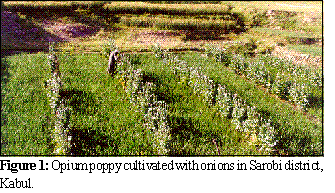
|
In the western region opium poppy cultivation has been verified for the first time in Shindand district in Farah province, although it was not possible to survey this district due to logistical constraints. Whilst opium poppy cultivation is currently limited to only a few hectares, further fieldwork has revealed that young men from Shindand who were found to work as itinerant harvesters in Helmand province are playing an important role in the expansion of opium poppy to the area.(9) It is reported that the threat of a rapid increase in opium poppy cultivation in Shindand district is exacerbated by its proximity to major opium trading routes, and the absence of off-farm and non-farm income opportunities in the area.
4.3. Monitoring through physical measurements
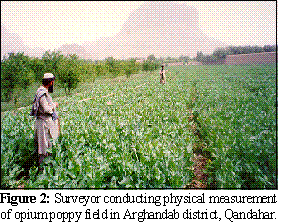
|
During the 1998 Survey physical measurements were successfully completed in many of the surveyed districts for the first time. This procedure was undertaken by the survey coordinators in collaboration with the surveyor who originally visually estimated the extent of village cultivation.
In 1999, this process was repeated successfully in 64 of the 106 districts in which theSurvey was conducted. The physical measurement approach serves as a valuable monitoring tool and as a basis for the selection of staff for the future implementation of the Survey.
4.4. Implementing and monitoring the survey in areas of conflict
Despite the continuing conflict in Afghanistan, the Survey was conducted in all but one of the districts in which opium poppy was reported in 1999. Whilst logistical constraints prevented a full survey being undertaken in Shindand district in Farah province, opium poppy cultivation was verified through the fieldwork for the second phase of Strategic Study 1: An Analysis of the Process of Expansion of Opium Poppy Cultivation to New Districts in Afghanistan.
The restrictions imposed on the mobility of international staff within Afghanistan, as a result of ongoing security concerns, meant that the monitoring of the Survey had to be undertaken by four national staff seconded from other projects within the Afghanistan programme. Each of these staff members was familiar with the methodology of theSurvey, having provided technical and logistical support in previous years. However, it is important to note that information collection in Afghanistan is subject to biases due to local capacity, pressures from the presumptive authorities and social norms and obligations.
4.5. Local bans on opium poppy cultivation
On 10 September 1997, the State High Commission for Drug Control stated that:
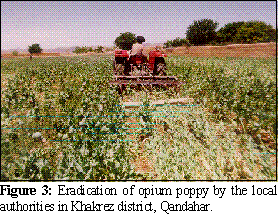
|
"The Islamic State of Afghanistan informs all compatriots that as the use of heroin and hashish is not permitted in Islam, they are reminded once again that they should strictly refrain from growing, using and trading in hashish and heroin. Anyone who violates this order shall be meted out a punishment in line with the lofty Mohammad and Sharia law and thus shall not be entitled to launch a complaint".
This declaration was subsequently amended by a clarification issued on 20 October 1997 which specifically banned the cultivation and trafficking of opium.
However, the Taliban authorities have continued to make the actual enforcement of the ban on opium cultivation, contingent on the provision of sufficient funds from the international development community to assist households in the transition from livelihoods dependent on opium poppy cultivation, to those based on legal sources of on-farm, off-farm and non-farm income.
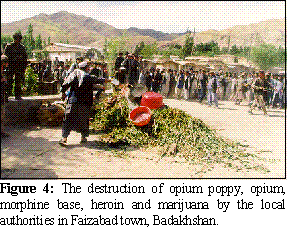 |
In May 1999, the State High Commission for Drug Control reported that the local authorities in Qandahar had eradicated approximately 400 hectares of opium in UNDCP's target districts of Ghorak, Khakrez and Maiwand. This report indicated that 200 hectares of opium poppy were eradicated in Ghorak, 175 hectares in Khakrez and 25 hectares in Maiwand. It is reported that none of the opium poppy eradicated had been lanced prior to its destruction.
Witnesses to elements of this operation included UN national staff from a number of different organisations, for example UNOCHA and UNHCR, as well as journalists based in Pakistan and Afghanistan. UNDCP national staff were also present during the eradication process in each of the three districts. However, due to the restrictions on the mobility of international staff within Afghanistan, it was not possible to send senior UNDCP staff to witness the eradication process. Moreover, due to logistical constraints it was not possible to undertake a systematic survey of the area eradicated under the auspices of the Survey.
Following local initiatives to ban opium cultivation in Zebak district in 1998, it is reported that the local authorities in Badakhshan have undertaken further action to expand the area under the ban to include the district of Eshkashem and parts of Baharak district. It is reported that concerns over the increasing use of opium amongst the local population, and prior commitments to the Agha Khan Development Network, prompted a local commander to take this action. Anecdotal reports and the results of the Survey suggest that, on the whole, the local population complied with the ban. However, it is claimed that those households that failed to comply with the ban were located in Wardooj Valley, and subsequently found their opium poppy eradicated. The amount of opium poppy eradicated in this area could not be verified by the survey team nor key informants.
In Faizabad, Badakhshan, it was reported that almost a half hectare of opium poppy was eradicated in June 1999. It is reported that this opium poppy was subsequently burnt, along with confiscated opium, morphine base, heroin and marijuana, in Faizabad town.
B. RESULTS
1. The Provinces and Districts Cultivating Opium Poppy in 1998/99
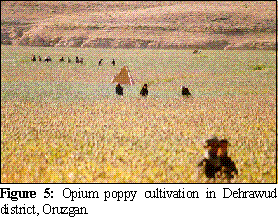 |
In total, an unprecedented 90,980 hectares of opium poppy were recorded by the Survey in Afghanistan in 1999. Moreover, opium poppy was surveyed in 104 districts in 18 different provinces in Afghanistan (see Table 1 and Annex B). Combined with the fact that opium poppy was confirmed, but not surveyed, in the district of Shindand, a total of 105 districts in Afghanistan were reported to have cultivated opium poppy in 1999.
As in previous years the provinces of Helmand and Nangarhar acounted for approximately three quarters of the opium poppy cultivated in Afghanistan. Helmand province alone was reported to cultivate 44,552 hectares of opium in 1999 compared to 30,673 hectares in 1998, representing an increase of approximately 45%.(10) In Nangarhar, opium poppy increased by a reported 5,168 hectares from the 1997/8 growing season to 22,990 hectares in 1998/9, representing an increase of approximately 29%.
Other major opium producing provinces included Qandahar (6,032 ha), Oruzgan (4,479 ha), Balkh (4,057), Badakhshan (2,684 ha) and Jawzjan (2,593 ha). An analysis of the figures suggests that these five provinces, combined with the provinces of Helmand and Nangarhar, accounted for approximately 96% of the total land under opium poppy cultivation in Afghanistan in 1999. The remaining 4% of land under opium cultivation was reported in the minor opium producing provinces of Baghlan (1,005 ha), Farah (787 ha), Kabul (132 ha), Kapisa (5 ha), Kunar (288 ha), Kunduz (38 ha), Laghman (287 ha), Logar (29 ha), Nimroz (203 ha), Takhar (201 ha) and Zabul (611 ha).
Compared with 1998, opium poppy cultivation in Afghanistan increased by 27,309 hectares, representing an increase of approximately 43% over the area estimated by the Survey in 1998. The significant increase in opium poppy cultivation in Helmand province accounted for 51% of the total increase in opium poppy cultivation in 1999. In Nangarhar, the 5,168 hectare increase in opium poppy cultivation in 1999 represented approximately 19% of the total increase in opium poppy cultivation in Afghanistan in 1999.
Figures suggest that the 27 districts in which opium poppy had not been reported prior to 1999 accounted for 12% of the 27,309 hectare increase in opium poppy cultivation in 1999, whilst the 4 districts in which opium was verified in 1998 but not surveyed, constituted only 1% of the increase in opium poppy cultivation between 1997/98 and 1998/99. The residual proportion of the 27,309 hectare increase is derived from the increases in opium poppy cultivation experienced in almost all the remaining opium poppy cultivating provinces.
| Table 1: Opium Poppy Cultivation in Afghanistan, 1994-1999(Hectares) | ||||||
Province |
1994 |
1995 |
1996 |
1997 |
1998 |
1999 |
Badakhshan |
1,714 |
2,970 |
3,230 |
2,902 |
2,817 |
2,684 |
Baghlan |
n/a |
n/a |
n/a |
328 |
929 |
1,005 |
Balkh |
n/a |
n/a |
1,065 |
710 |
1,044 |
4,057 |
Farah |
n/a |
9 |
630 |
568 |
171 |
787 |
Helmand |
29,579 |
29,753 |
24,909 |
29,400 |
30,673 |
44,552 |
Jawzjan |
n/a |
n/a |
n/a |
n/a |
n/a |
2,593 |
Kabul |
n/a |
n/a |
n/a |
n/a |
n/a |
132 |
Kapisa |
n/a |
n/a |
n/a |
n/a |
n/a |
5 |
Kunar |
115 |
152 |
19 |
0 |
75 |
288 |
Kunduz |
n/a |
n/a |
n/a |
n/a |
n/a |
38 |
Laghman |
0 |
0 |
0 |
0 |
77 |
297 |
Logar |
0 |
0 |
0 |
0 |
4 |
29 |
Nangarhar |
29,081 |
15,722 |
15,643 |
14,567 |
17,822 |
22,990 |
Nimroz |
682 |
119 |
136 |
642 |
11 |
203 |
Oruzgan |
6,211 |
2,573 |
7,777 |
4,587 |
4,288 |
4,479 |
Qandahar |
4,034 |
2,461 |
3,160 |
4,521 |
5,602 |
6,032 |
Takhar |
n/a |
n/a |
n/a |
n/a |
n/a |
201 |
Zabul |
54 |
n/a |
255 |
154 |
161 |
611 |
Total |
71,470 |
53,759 |
56,824 |
58,416 |
63,674 |
90,983 |
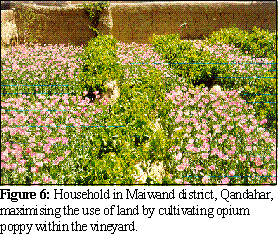
|
Indeed, between 1998 and 1999, opium cultivation increased in almost all the surveyed provinces. Only the province of Badakshan (-5%) was found to have reduced the extent of cultivation. Amongst the major opium producing provinces, Balkh (+289%) experienced the largest increase in opium poppy cultivation between 1998 and 1999, followed by Helmand (+45%) Nangarhar (+29%), Qandahar (+8%), and Oruzgan (+4%). The level of opium poppy cultivation in Jawzjan (2,593 ha) is particularly significant given that opium poppy cultivation had not been reported and surveyed within the province prior to the 1998/99 growing season.
Given the scale of opium poppy cultivation in the minor opium growing provinces the rate of increase in opium poppy cultivation is high. The absolute increase is, however, relatively insignificant, representing only 8% of the increase in opium poppy cultivation between 1998 and 1999.
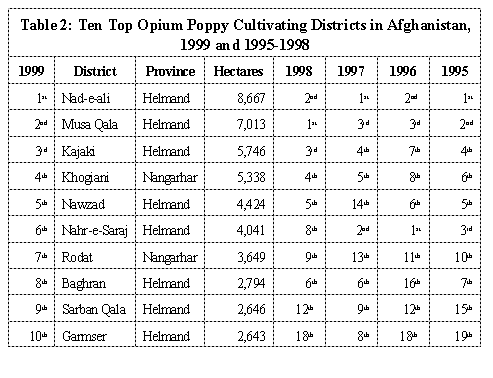 |
At the district level, of the 73 districts that were surveyed in the 1997/98 growing season, almost 80% were found to have increased opium poppy cultivation in 1999. As in previous years, the districts with the highest level of cultivation tended to be located in the provinces of Helmand and Nangarhar (see Table 2). It is interesting to note that eight of the ten districts with the highest level of opium poppy cultivation in 1997/98 also feature in 1998/99. Indeed, the five highest cultivating districts in 1998/99 are ranked the same as in 1997/98 except for the renewed dominance of Nade-e-ali as the district with the highest level of opium cultivation in Afghanistan, a position it would seem to have enjoyed for three of the last five years.
According to the Survey, the results of UNDCP's Poppy Reduction Project were mixed with a reduction in opium poppy cultivation in the districts of Maiwand and Ghorak and an increase in the districts of Shinwar and Khakrez.
2. Estimated Opium Production and Yield in 1998/99
It is important to note that security constraints and the sheer diversity in agricultural practices, the varieties of opium poppy cultivated, and the altitude and climate of poppy growing areas, have constrained the development of an accurate methodology to ascertain opium yields in Afghanistan.(11) In the absence of a more reliable methodology, UNDCP continues to use farmers' estimates of opium yield to calculate the annual opium production figures for Afghanistan. In 1998 the problems associated with this methodology were highlighted by the unusual weather conditions experienced during the opium poppy harvest.
In the 1998/99 opium poppy growing season it is reported that households in most provinces in Afghanistan have benefitted from particularly good yields. As opposed to reports of extensive crop damage in Helmand, Oruzgan, Qandahar and Badakhshan in 1997/98, there have been no reports of crop damage in the 1998/99 opium poppy growing season.
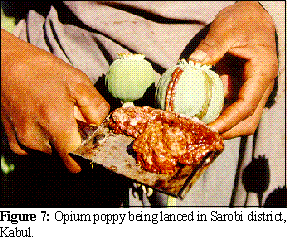
|
Cold nights and warm days during the harvesting period in the southern and eastern regions have also provided the appropriate conditions for higher yields. Indeed, the increase in size of opium poppy capsules was noted in the eastern and southern zones during the course of the implementation of the Survey (See Figure 7).(12) As such, ecological conditions in Afghanistan in 1999 were particularly conducive for opium poppy cultivation, resulting in an increase in average yields per hectare in 85% of the provinces where the Survey was conducted in 1998.
Based on the expected yields cited by respondents during the Survey, the total production of opium in Afghanistan in 1999 is an estimated 4,581 metric tonnes (mt), representing a 40% increase on the 1998 expected yield of 3,269 mt derived from respondents estimated yields prior to harvest. Using the 1998 deflated figure of 2,102 mt, that incorporated reports of significantly reduced yields in Helmand, Qandahar, Oruzgan and Badakhshan, there was an increase in opium production in Afghanistan of approximately 117% between 1998 and 1999. However, using the actual yields for 1998, derived from responses to the 1999 Survey, it is estimated that 2,692 mt of opium were produced in 1998. This would suggest an estimated increase in opium production of 70% between 1998 and 1999.
In 1999, provincial yields ranged from 9.33 kg/ha for rainfed land in Badakhshan to 72 kg/ha for irrigated opium poppy in Oruzgan province. However, on a district basis, yields ranged from 7.42 kg/ha in Faizabad district Badakhshan to 101.95 kg/ha in Dehrawud, Oruzgan. The average national opium yield was 50.35 kg/ha in 1999.
C. CONCLUSION
It is clear that opium poppy cultivation has increased significantly in the 1998/99 season. The increase in the number of districts in which opium poppy was reported and surveyed has been significant, rising from 73 in 1998 to 104 in 1999. Moreover, almost 80% of those districts surveyed in 1998 have experienced an increase in opium poppy cultivation in 1998/99
However, it is important to recognise that the socio-economic and ecological conditions in Afghanistan were particularly conducive for opium poppy cultivation during the 1998/99 growing season. High opium prices during the planting season in the eastern and southern regions, combined with ideal weather conditions during the harvest, led to an increase in the cultivation and production of opium poppy cultivation.
In particular, it is important to recognise that the particularly poor harvest in 1998 led to significant reductions in the opium yield in the provinces of Helmand, Qandahar and Oruzgan, resulting in a substantial increase in the post harvest price of opium in the southern region. Indeed, an analysis of dry opium prices between August 1997 and July 1999 reveals that in the southern region the price of dry opium was the equivalent of US$60 during the 1998 planting season in October/ November, compared to US$33 at the same time in 1997 (see graph on next page).(13) In the eastern region the price of dry opium was 15% higher during the planting season in 1998, than it was in 1997.(14)
The fieldwork for Strategic Study 3: The Role of Opium as a Source of Informal Creditrevealed that at the micro level households experienced a shortfall in the repayment of their credit, as well as savings in the southern region during 1998. Consequently, the resource poor, who typically sell much of their opium crop in advance, often failed to repay the debts they incurred during the winter of 1997/98 due to the poor harvest. It is reported that in order to repay these debts and the interest payments accrued, as well as the new loans they envisaged obtaining during the winter of 1998/99, many of these households increased their opium poppy cultivation during the 1998/99 opium poppy season.(15)
Similarly, those relatively wealthier households that retain opium as a form of savings were found to have depleted their existing stock of opium due to the poor yield in 1998. It would seem that to maintain their stock and safeguard against future crisis, these households cultivated more opium in the 1998/99 opium poppy season. Consequently, it would seem that the poor yield in 1998, combined with the interrelated issue of high prices during the opium planting season for 1998/99, have resulted in a significant increase in opium poppy cultivation in the southern region in 1999, particularly in Helmand province.
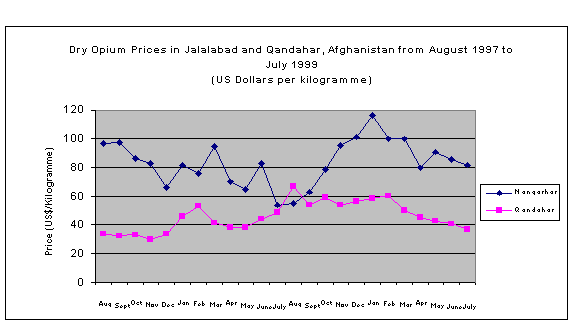 |
However, it is important to recognise that if the exogenous demand factors remain constant, it is probable that there will be a reduction in opium poppy cultivation in 2000. In-depth fieldwork has revealed that itinerant harvesters negotiated a substantial increase in their share of the final opium crop in the southern region during the harvest in 1999.(16) Moreover, dry opium prices in the south fell from a pre-harvest rate of US$60 per kilogramme to US$37 per kilogramme during the harvest period, returning to their 1997 price levels. It is expected that the rise in labour costs combined with the fall in the price of dry opium will ultimately have an impact on households' perception of the relative profitability of opium poppy for the 1999/2000 season, and a subsequent reduction in opium poppy cultivation.
ANNEX A: Major Opium Poppy Growing Provinces (Hectares)
|
|
|
|
|
|
|
|
Minor Opium Poppy Growing Provinces
(Hectares)
|
|
|
|
|
|
|
|
|
|
|
|
ANNEX B: STATISTICS
Opium Poppy Cultivation, 1994-1999 (Hectares) |
||||||||
Province |
District |
Land Cultivated with Poppy |
Share |
|||||
1994 |
1995 |
1996 |
1997 |
1998 |
1999 |
|||
Badakhshan |
Baharak |
111 |
64 |
116 |
9 |
202 |
23 |
0.03 |
Eshkashem |
0 |
0 |
3 |
0 |
0 |
0 |
0 |
|
Faizabad |
77 |
2,344 |
1,592 |
1,634 |
1,282 |
906 |
1.00 |
|
Jurm |
433 |
555 |
1,326 |
1,051 |
1,198 |
1,249 |
1.37 |
|
Keshem |
1,093 |
3 |
177 |
62 |
62 |
385 |
0.42 |
|
Ragh |
0 |
0 |
8 |
31 |
2 |
8 |
0.01 |
|
Shahr-e-Bozorg |
0 |
0 |
0 |
0 |
71 |
113 |
0.12 |
|
Zebak |
0 |
4 |
8 |
115 |
0 |
0 |
0.00 |
|
Total: |
1,714 |
2,970 |
3,230 |
2,902 |
2,817 |
2,684 |
2.95 |
|
Baghlan |
Dahaneh-e-Ghowri |
n/a |
n/a |
n/a |
328 |
929 |
967 |
1.06 |
Pul-e-Khumri |
n/a |
n/a |
n/a |
n/a |
n/a |
38 |
0.04 |
|
Total: |
n/a |
n/a |
n/a |
328 |
929 |
1,005 |
1.10 |
|
Balkh |
Balkh |
n/a |
n/a |
n/a |
13 |
29 |
29 |
0.03 |
Char Bulaq |
n/a |
n/a |
n/a |
165 |
530 |
2,600 |
2.86 |
|
Chemtal |
n/a |
n/a |
1,065 |
532 |
485 |
1,428 |
1.57 |
|
Total: |
n/a |
n/a |
1,065 |
710 |
1,044 |
4,057 |
4.46 |
|
Farah |
Bakwah |
n/a |
1 |
13 |
129 |
31 |
129 |
0.14 |
Bala Balok |
n/a |
8 |
19 |
169 |
36 |
186 |
0.20 |
|
Farah |
n/a |
n/a |
18 |
18 |
10 |
44 |
0.05 |
|
Gulestan |
n/a |
n/a |
581 |
252 |
94 |
428 |
0.47 |
|
Total: |
n/a |
9 |
630 |
568 |
171 |
787 |
0.86 |
|
Helmand |
Baghran |
n/a |
2,519 |
1,267 |
2,754 |
2,910 |
2,794 |
3.07 |
Bust |
2,256 |
885 |
1,054 |
1,325 |
1,869 |
2,528 |
2.78 |
|
Garmser |
786 |
725 |
942 |
1,993 |
1,205 |
2,643 |
2.90 |
|
Kajaki |
979 |
4,087 |
2,814 |
3,904 |
3,959 |
5,746 |
6.32 |
|
Musa Qala |
1,154 |
5,137 |
3,924 |
4,360 |
5,574 |
7,013 |
7.71 |
|
Nad-e-ali |
12,529 |
5,983 |
4,035 |
5,102 |
5,156 |
8,667 |
9.53 |
|
Nahr-e-Saraj |
590 |
4,716 |
4,309 |
4,807 |
2,426 |
4,041 |
4.44 |
|
Naw Zad |
2,345 |
2,799 |
3,596 |
1,585 |
3,605 |
4,424 |
4.86 |
|
Nawa Barakzai |
6,074 |
1,254 |
505 |
722 |
1,150 |
2,581 |
2.84 |
|
Sarban Qala |
2,866 |
973 |
1,909 |
1,971 |
1,734 |
2,646 |
2.91 |
|
Washir |
n/a |
676 |
555 |
877 |
1,084 |
1,469 |
1.61 |
|
Total: |
29,579 |
29,753 |
24,909 |
29,400 |
30,673 |
44,552 |
48.97 |
|
Herat |
Pashtun Zarghun |
0 |
0 |
0 |
38 |
0 |
0 |
0 |
Total: |
0 |
0 |
0 |
38 |
0 |
0 |
0 |
|
Jawzjan |
Aqchah |
n/a |
n/a |
n/a |
n/a |
n/a |
532 |
0.58 |
Faizabad |
n/a |
n/a |
n/a |
n/a |
n/a |
43 |
0.05 |
|
Manga Jek |
n/a |
n/a |
n/a |
n/a |
n/a |
1,789 |
1.97 |
|
Mardian |
n/a |
n/a |
n/a |
n/a |
n/a |
43 |
0.05 |
|
Qarqin |
n/a |
n/a |
n/a |
n/a |
n/a |
186 |
0.20 |
|
Total: |
n/a |
n/a |
n/a |
n/a |
n/a |
2,593 |
2.85 |
|
Kabul |
Sarobi |
n/a |
n/a |
n/a |
n/a |
n/a |
132 |
0.15 |
Total: |
n/a |
n/a |
n/a |
n/a |
n/a |
132 |
0.15 |
|
Kapisa |
Tagab |
n/a |
n/a |
n/a |
n/a |
n/a |
5 |
0.01 |
Total: |
n/a |
n/a |
n/a |
n/a |
n/a |
5 |
0.01 |
|
Kunduz |
Aliabad |
n/a |
n/a |
n/a |
n/a |
n/a |
5 |
0.01 |
Chahar Darreh |
n/a |
n/a |
n/a |
n/a |
n/a |
8 |
0.01 |
|
Emam Saheb |
n/a |
n/a |
n/a |
n/a |
n/a |
3 |
0.00 |
|
Khanabad |
n/a |
n/a |
n/a |
n/a |
n/a |
2 |
0.00 |
|
Kunduz |
n/a |
n/a |
n/a |
n/a |
n/a |
9 |
0.01 |
|
Qala-e Zal |
n/a |
n/a |
n/a |
n/a |
n/a |
11 |
0.01 |
|
Total: |
n/a |
n/a |
n/a |
n/a |
n/a |
38 |
0.04 |
|
Kunar |
Asadabad |
n/a |
n/a |
n/a |
n/a |
n/a |
73 |
0.08 |
Bar Kunar |
n/a |
n/a |
n/a |
n/a |
n/a |
47 |
0.05 |
|
Chawki |
13 |
11 |
0 |
0 |
8 |
9 |
0.01 |
|
Khas Kunar |
75 |
82 |
10 |
0 |
12 |
50 |
0.05 |
|
Mazar (Nur Gul) |
27 |
19 |
5 |
0 |
8 |
28 |
0.03 |
|
Narang |
n/a |
15 |
1 |
0 |
13 |
27 |
0.03 |
|
Sarkani |
n/a |
25 |
2 |
0 |
34 |
54 |
0.06 |
|
Total: |
115 |
152 |
19 |
0 |
75 |
288 |
0.32 |
|
Laghman |
Alingar |
0 |
0 |
0 |
0 |
2 |
71 |
0.08 |
Alishang |
0 |
0 |
0 |
0 |
3 |
26 |
0.03 |
|
Metarlam |
0 |
0 |
0 |
0 |
14 |
72 |
0.08 |
|
Qarghai |
0 |
0 |
0 |
0 |
58 |
128 |
0.14 |
|
Total: |
0 |
n/a |
n/a |
n/a |
77 |
297 |
0.33 |
|
Logar |
Azro |
n/a |
n/a |
n/a |
n/a |
4 |
29 |
0.03 |
Total: |
n/a |
n/a |
n/a |
n/a |
4 |
29 |
0.03 |
|
Nangarhar |
Achin |
5,354 |
2,187 |
2,315 |
1,640 |
1,693 |
2,209 |
2.43 |
Bati Kot |
3,797 |
529 |
392 |
1,013 |
2,034 |
603 |
0.66 |
|
Behsud |
458 |
31 |
51 |
123 |
397 |
946 |
1.04 |
|
Chaparhar |
1,089 |
1,377 |
1,750 |
1,234 |
1,365 |
977 |
1.07 |
|
Darae Noor |
1,302 |
392 |
199 |
73 |
199 |
734 |
0.81 |
|
Deh Bala |
307 |
646 |
354 |
569 |
511 |
468 |
0.51 |
|
Durbaba |
29 |
78 |
38 |
39 |
56 |
50 |
0.05 |
|
Goshta |
1,249 |
467 |
116 |
77 |
122 |
240 |
0.26 |
|
Hesarak |
202 |
453 |
253 |
370 |
436 |
741 |
0.81 |
|
Jalalabad City |
0 |
0 |
0 |
0 |
0 |
33 |
0.04 |
|
Kama |
0 |
18 |
0 |
0 |
198 |
389 |
0.43 |
|
Khogiani |
4,347 |
2,577 |
2,628 |
3,385 |
3,808 |
5,338 |
5.87 |
|
Kuz Konar |
293 |
233 |
115 |
15 |
105 |
236 |
0.26 |
|
La'lpur |
302 |
267 |
79 |
66 |
137 |
270 |
0.30 |
|
Mohmand Dara |
1,630 |
0 |
156 |
83 |
125 |
290 |
0.32 |
|
Nazian |
343 |
138 |
251 |
111 |
252 |
184 |
0.20 |
|
Pachier wa Agam |
768 |
571 |
681 |
400 |
488 |
731 |
0.80 |
|
Rodat |
1,026 |
2,038 |
1,959 |
1,583 |
2,147 |
3,649 |
4.01 |
|
Sherzad |
1,954 |
2,351 |
1,646 |
1,689 |
1,302 |
1,741 |
1.91 |
|
Shinwar |
3,884 |
1,265 |
2,075 |
1,478 |
1,374 |
1,559 |
1.71 |
|
Sorkh Rod |
747 |
106 |
587 |
619 |
1,072 |
1,602 |
1.76 |
|
Total: |
29,081 |
15,722 |
15,643 |
14,567 |
17,822 |
22,990 |
25.27 |
|
Nimroz |
Kang |
10 |
2 |
1 |
107 |
5 |
2 |
0.00 |
Khash Rud |
672 |
117 |
135 |
535 |
6 |
201 |
0.22 |
|
Total: |
682 |
119 |
136 |
642 |
11 |
203 |
0.22 |
|
Oruzgan |
Ajristan |
313 |
0 |
0 |
0 |
0 |
0 |
0 |
Char Chashma |
1,337 |
12 |
0 |
0 |
1,158 |
1,110 |
1.22 |
|
Chora |
694 |
424 |
1,574 |
233 |
652 |
932 |
1.02 |
|
Dehrawud |
909 |
938 |
2,923 |
1,870 |
1,033 |
1,243 |
1.37 |
|
Gezab |
1,476 |
16 |
8 |
0 |
0 |
0 |
0 |
|
Khas Oruzgan |
0 |
4 |
0 |
0 |
0 |
0 |
0 |
|
Tirin Kot |
1,428 |
1,180 |
3,271 |
2,484 |
1,445 |
1,194 |
1.31 |
|
Total: |
6,211 |
2,573 |
7,777 |
4,587 |
4,288 |
4,479 |
4.92 |
|
Qandahar |
Arghandab |
211 |
87 |
331 |
561 |
399 |
750 |
0.82 |
Arghistan |
n/a |
n/a |
n/a |
n/a |
n/a |
38 |
0.04 |
|
Daman |
n/a |
n/a |
n/a |
n/a |
n/a |
110 |
0.12 |
|
Dand |
299 |
53 |
234 |
21 |
73 |
227 |
0.25 |
|
Ghorak |
347 |
803 |
692 |
1,503 |
1,126 |
1,109 |
1.22 |
|
Kandahar |
21 |
0 |
0 |
0 |
0 |
0 |
0 |
|
Khakrez |
362 |
274 |
627 |
286 |
518 |
632 |
0.69 |
|
Maiwand |
256 |
333 |
618 |
1,278 |
2,497 |
2,022 |
2.22 |
|
Maruf |
30 |
16 |
1 |
0 |
3 |
5 |
0.01 |
|
Nesh |
410 |
334 |
104 |
399 |
373 |
510 |
0.56 |
|
Panjwai |
250 |
357 |
266 |
255 |
134 |
132 |
0.15 |
|
Shah Wali Kot |
678 |
97 |
94 |
127 |
162 |
236 |
0.26 |
|
Spin Boldak |
1,170 |
107 |
194 |
91 |
317 |
261 |
0.29 |
|
Total: |
4,034 |
2,461 |
3,160 |
4,521 |
5,602 |
6,032 |
6.63 |
|
Takhar |
Chah Ab |
n/a |
n/a |
n/a |
n/a |
n/a |
17 |
0.02 |
Chal |
n/a |
n/a |
n/a |
n/a |
n/a |
8 |
0.01 |
|
Farkhar |
n/a |
n/a |
n/a |
n/a |
n/a |
6 |
0.01 |
|
Kalafgan |
n/a |
n/a |
n/a |
n/a |
n/a |
101 |
0.11 |
|
Khvajeh Ghar |
n/a |
n/a |
n/a |
n/a |
n/a |
9 |
0.01 |
|
Rostaq |
n/a |
n/a |
n/a |
n/a |
n/a |
10 |
0.01 |
|
Taloqan |
n/a |
n/a |
n/a |
n/a |
n/a |
16 |
0.02 |
|
Warsaj |
n/a |
n/a |
n/a |
n/a |
n/a |
12 |
0.01 |
|
Yangi Qala |
n/a |
n/a |
n/a |
n/a |
n/a |
22 |
0.02 |
|
Total: |
n/a |
n/a |
n/a |
n/a |
n/a |
201 |
0.22 |
|
Zabul |
Arghandab |
0 |
0 |
0 |
0 |
0 |
74 |
0.08 |
Dai Chopan |
0 |
0 |
0 |
0 |
0 |
41 |
0.05 |
|
Jaldak |
0 |
0 |
0 |
0 |
0 |
77 |
0.08 |
|
Mizan |
54 |
0 |
255 |
154 |
160 |
373 |
0.41 |
|
Qalat |
0 |
0 |
0 |
0 |
1 |
46 |
0.05 |
|
Total: |
54 |
0 |
255 |
154 |
161 |
611 |
0.67 |
|
National Total: |
71,470 |
53,759 |
56,824 |
58,416 |
63,674 |
90,983 |
100 |
|
ANNEX C: METHODOLOGY & IMPLEMENTATION
1. The Survey Team
The Survey was conducted by 98 surveyors, 11 survey coordinating teams, and 4 national programme staff over a three month period. In the southern, western and eastern regions the coordinating teams comprised of one UNDCP Survey Coordinator, one trainee coordinator, nominated by either the Nangarhar Drug Control Coordination Unit (NDCCU) or the Qandahar Drug Control Coordination Unit (QDCCU), and one local guide provided by the authorities. In the northern region 2 Coordinators were employed who were monitored intensively throughout the implementation of the Survey by one member of UNDCP's national programme staff. Indeed, in 1999, four UNDCP Afghanistan Programme staff were tasked with monitoring both the surveyors and the coordinators on a permanent basis throughout the implementation of the Survey. The design of the database, data entry and data analysis was undertaken by three staff. In total theSurvey employed 127 technical staff.
The selection of survey team members was based on their past experience. All had previous experience of conducting surveys with NGOs or other UN agencies. Moreover, to ensure continuity of results there is a preference for employing surveyors and coordinators who have previously conducted the Survey to the standard required. Indeed, 51 of the survey team in 1999 undertook the opium poppy survey in 1998, whilst 15 surveyors have implemented the Survey since its inception in 1994.
All the surveyors were assigned to a province and a district which they were familiar with, either as inhabitants of the area, or from previous experience of working there. Past practice has indicated that this has proven vital to the success of the Survey, ensuring access to the areas of opium poppy cultivation without interference from local farmers. Some of the surveyors also acquired the services of a local guide who was often provided by the local authorities or by influential people within the district.
2. Training of Surveyors
Due to the restrictions on the mobility of international staff within Afghanistan, training for the Survey was undertaken in both Pakistan and Afghanistan in 1999. The Survey Team Leader provided initial training to survey coordinators and national programme staff responsible for the implementation of the Survey in Quetta and Peshawar. This initial training was then cascaded down to surveyors in Afghanistan through a series of workshops in Jalalabad, Qandahar and Faizabad. The training workshops consisted of a series of lectures, role plays and field visits over a four day period. These workshops also provided a forum for survey coordinators and national programme staff to make logistical arrangements for the implementation and monitoring of the Survey.
Day one of training consists of an introduction to the Survey, including the objectives and rationale of the Survey in Afghanistan. Districts are allocated to both surveyors and coordinators, with the allocation of districts determined by the surveyor's knowledge of the area. On average one district is allocated to each surveyor, whilst each coordinator is given the task of monitoring the implementation of the Survey in five districts. However, where a district is particularly large, or contains a large number of villages, two surveyors are tasked with conducting the Survey in that area. On the second day, surveyors are also introduced to their respective coordinators and logistical arrangements for both monitoring and physical measurements are made.
Day two introduces the questionnaire to the surveyors (see Annex D). A thorough review of the questionnaire is undertaken with the surveyors and the approach required for each question is discussed. After an initial question and answer session the group is divided into groups of two to practice their interviewing techniques through role playing exercises. After a review of the completed questionnaires, another question and answer session is held to resolve any outstanding problems with the questionnaire.
Day three is dedicated to fieldwork. Fieldwork typically comprises of surveyors and coordinators making individual visual estimates of selected fields. Each surveyor's estimate is noted before each field is physically measured. After the field is physically measured, the estimates of the surveyors are discussed and advice on remedial action is offered to those whose estimates are more than 10% from the figure determined by the physical measurement. In particular, surveyors are encouraged to pace the field to gain greater perspective of the distances involved.
To test the estimates of the surveyors a number of fields of varying sizes and shapes are measured, visually and physically. Towards the end of the day, the range of estimates from the surveyors is generally found to reduce considerably, as does the variation of these estimates from the physical measurements.
Day Four of training is usually dedicated to the training of the coordinators. Given the inadequacy of existing maps of Afghanistan, advice regarding the procedure for updating the maps of the survey districts is also given a priority. The fourth day culminates in a final lecture regarding the importance of the Survey and the integrity of the data collected.
3. The Census Method
After comprehensive training the surveyors are provided with forms, district maps and a list of villages in the district they are to survey. In general, one surveyor is allocated to each district, giving the surveyor enough time to survey all the agricultural land in the district and ensure the accuracy of the estimates of opium poppy cultivation in each village. Each surveyor is charged with surveying at least two villages a day, completing a separate form for each village. After walking throughout the village agricultural land and visually estimating the land under opium poppy cultivation, surveyors consult key informants within the village to verify their findings.
4. Definition of a 'Village'
One of the main difficulties that the Survey faced during its initial years of implementation, was in reaching a workable definition of a 'village'. In 1994, the first year of the Survey, the issue of defining a 'village' was not specifically addressed during survey design. It was assumed that a village was a unit which was easily recognised and identified by anyone, particularly village inhabitants and trained field surveyors.
However, during the implementation of the first survey, it became apparent that, within the context of Afghanistan, even a single house built a short distance from the rest of the houses in an area was considered as a separate village. It was established that if surveyors were required to complete a form for each of these houses/villages, several thousand extra forms would have required processing. In addition, it was decided that this definition would not allow valid comparisons in the data over even a short time period due to the constant changes in the number of houses found in any given location.
Consequently, for the purpose of the 1995 Survey, a village was defined as a collection of 30-100 houses based on the perception that the majority of villages in Afghanistan fell into this category. The surveyors were instructed that where a village was fewer than 30 houses, it should be combined with a neighbouring village to reach the required size and one form should be completed for both villages. Where a village was larger than 100 houses, surveyors were instructed to divide the village into units of 100 houses and complete one form for each unit. However, when the results of the Survey were reviewed, UNDCP realised that this approach resulted in a number of errors due to the 10% of villages that failed to correspond to the 30-100 household criteria.
In 1996, UNDCP decided that a village would be defined as a congregation of households having a separate and distinct boundary for its agricultural land. One survey form would be completed for each such 'village' regardless of its size. This definition has, on analysis, proven to be the most accurate so far. It has made the survey process easier for the surveyors, as the majority of households in Afghanistan have been found to know the boundaries of the agricultural land of their village. UNDCP has continued to use this definition to monitor the changing levels of opium poppy cultivation in each 'village'.
As part of the 1998 Survey, the 'village' definition was amended for the target districts of the Afghanistan Programme. This change was to ensure that the 'village' as defined by the planning process for the Poppy Crop Reduction Project (C28) was consistent with the area being measured by the Survey, thereby allowing UNDCP to monitor the degree of compliance with the Drug Control Action Plans at the district and village level.
To achieve consistency, programme staff familiar with the villages within the district and their respective shuras, accompanied the surveyors during their field visits to the districts of Ghorak, Khakrez, Maiwand and Shinwar. This practice was repeated during the implementation of the Survey in 1999.
5. Estimating Land Under Opium Poppy Cultivation
Initially surveyors determine the boundaries of a village's agricultural land and walk through areas used for agricultural activities, estimating both the land dedicated to opium poppy cultivation and the total land under cultivation.
To verify their findings the surveyors are required to ask a number of village informants to estimate the total area of land cultivated in their village and the total area under opium poppy cultivation, as well as the expected yield of opium per jerib.(17)
6. Data Collection
The surveyors question key informants according to the questionnaire prepared by UNDCP. All members of the survey team are provided with copies of the survey questionnaire, and a map and list of the villages to be surveyed. Following the survey instructions, surveyors complete one questionnaire for each village.
Three persons are interviewed in each village. A record of what is said and the surveyors observations are kept in a note book. These are subsequently entered on the survey forms at the end of each day. Each surveyor is required to keep a daily record of their activities which is made available to the survey coordinators on request.
7. Monitoring the Survey
UNDCP recognises that a ground based census survey of illicit crops requires close monitoring during implementation. Inherent biases associated with logistical arrangements, cultural obligations and the various vested interests that are at play, have to be addressed. Within the Survey different levels of monitoring have been established to ensure the integrity of the data produced.
- The first level of monitoring consists of coordinators who are responsible for monitoring the work of the surveyors undertaking the core fieldwork. This level of monitoring is conducted on a systematic basis with coordinators taking responsibility for reviewing the work of a number of surveyors in the field through reviewing the data produced, regular field visits and physical measurements. This work is done in conjunction with coordinators from the Drug Control and Coordination Units (DCCUs) in both Qandahar and Nangarhar.
- The second level of monitoring is undertaken by UNDCP field staff. These staff manage many of the day to day logistics of the Survey and undertake field visits and resolve operational problems as they arise. At this level of monitoring, preference is given to those UNDCP field staff with experience of undertaking land-use surveys and who have contracts extending over the lifetime of the Afghanistan programme. These staff have a vested interest to ensure that theSurvey is implemented in accordance with the approved methodology and that biases are kept to a minimum.
- The third level of monitoring is that of the international staff employed under the Drug Control Monitoring System. Each year these staff members visit a number of different locations throughout the implementation of the Survey to ensure that it is being implemented as planned and to assess the integrity of the estimates provided by the Survey team. In the past, these missions have proven to be an important basis for maintaining the motivation and discipline of the survey staff.
In 1999, due to restrictions on the mobility of international staff within Afghanistan, this third level of monitoring has been undertaken by four national staff seconded from other projects within the Afghanistan programme. Each of these staff members is familiar with the methodology and implementation of the Survey, having provided technical and logistical support in previous years.
8. Data Input and Analysis
After checking in the field by coordinators and national monitors, survey forms are submitted to Islamabad for processing and input. This is undertaken by the data analyst and two staff responsible for data input.
The village code for each survey form submitted is checked against the previous years entries. Any new villages surveyed are allocated a new code to ensure that each entry in the database is unique. In total, 6,842 forms were entered in 1999 compared to 5,433 in 1995.
Data cleaning and analysis is undertaken by the data analyst in consultation with the Survey Team Leader and the Project Manager.
9. Report Writing and Distribution
The report is written in August and submitted to UNDCP headquarters in Vienna for comments. The final report is ready for distribution by the first week of September each year. In total more than 1200 copies of the Survey are distributed to a variety of different organisations, including key policy makers in multilateral, bilateral and non governmental development organisations, as well as journalists and law enforcement officials in over 20 different countries.
ANNEX D: SURVEY QUESTIONNAIRE
Opium Poppy Cultivation
SURVEY FORM 1999
Surveyor: _______________ Date:____________ Village____________________
Code: ______________ Province:_______________District: ____________
Area:__________ Village: __________________ No. of households: ___________
1. Is there opium poppy cultivation in this village ? Yes: No
2. What is the total area of the cultivated land ? (Surveyor's estimate in jeribs)Irrigated: _________ Rain-fed _________
3. What is the total area of land cultivated with opium poppy ? (Surveyor's estimate in jeribs) Irrigated: _________ Rainfed _______
4. What is the farmer's estimates of the total cultivated land and land cultivated with opium poppy?
Farmers |
Total Land (jeribs) |
Land Cultivated with Opium poppy (jeribs) |
||
Irrigated |
Rainfed |
Irrigated |
Rainfed |
|
No. 1 |
|
|
|
|
No. 2 |
|
|
|
|
No. 3 |
|
|
|
|
5. What is the farmer's estimates of wheat and opium yield this year and last year from 1 jerib of his land ?
Farmers |
1998 yield (Actual) |
1999 yield (Estimated) |
||||||
Opium |
Wheat |
Opium |
Wheat |
|||||
Rainfed |
Irrigated |
Rainfed |
Irrigated |
Rainfed |
Irrigated |
Rainfed |
Irrigated |
|
No. 1 |
|
|
|
|
|
|
|
|
No. 2 |
|
|
|
|
|
|
|
|
No. 3 |
|
|
|
|
|
|
|
|
6. Has there been any change in opium poppy cultivation since 1998 ? (Place an X in the appropriate box)
Farmers |
No change |
Increased |
Decreased |
No. 1 |
|
|
|
No. 2 |
|
|
|
No. 3 |
|
|
|
7. Have there been any opium poppy eradication efforts in this season ?
(Place an X in the appropriate box) if yes, explain in the comments section.
Farmers |
Yes |
No |
No. 1 |
||
No. 2 |
||
No. 3 |
8. Has the opium poppy crop suffered any damage ?
Farmers |
Yes |
No |
Extent (%) |
Reason |
No. 1 |
|
|
|
|
No. 2 |
|
|
|
|
No. 3 |
|
|
|
|
9. What is the present price of opium and wheat ? (Price in Afs./Kg)
Farmers |
Dry Opium |
Fresh Opium |
Wheat |
No. 1 |
|
|
|
No. 2 |
|
|
|
No. 3 |
|
|
|
10. Have any rehabilitation / development activities been implemented in this village during the last year ?
Farmers |
Yes |
No |
Description |
Implementing Agency |
No. 1 |
|
|
|
|
No. 2 |
|
|
|
|
No. 3 |
|
|
|
|
GPS Position:
Latitude__________ Longitude __________Altitude __________ (metre)
Land under opium poppy as per Physical measurement_________jeribs
Comments and Observations:
1. It is interesting to note that in the provinces of Kunar, Laghman and Nangarhar the rentable value of land is increasingly being determined on the basis of the potential productivity of the land in terms of opium rather than, as tradition dictated, wheat. Reports suggest that those households seeking to lease land in these areas now have little option but to cultivate opium poppy.
2. For more details see Strategic Study 3: The Role of Opium as a Source of Informal Credit. UNDCP: Islamabad.
3. For more details see Strategic Study 4: Access to Labour: The Role of Opium in the Livelihood Strategies of Itinerant Harvesters Working in Helmand Province, Afghanistan. UNDCP: Islamabad.
4. All opium production and yield figures cited in this report refer to dry opium which on average is estimated to weigh 30% less than fresh, or wet, opium.
5. For more details see Strategic Study 4: Access to Labour: The Role of Opium in the Livelihood Strategies of Itinerant Harvesters Working in Helmand Province, Afghanistan. UNDCP: Islamabad.
6. Typically itinerant harvesters in the southern region are paid in-kind with one sixth to one fifth of the opium yield. However in 1999, itinerant harvesters received one fifth to one quarter of the final yield, and in some areas were no longer liable for the payment of ushr due to landowners agreeing to pay the agricultural tax from their share of the final crop. In Helmand province this represented an increase from the equivalent of US$2.50 per day to between US$5.20 and US$6.40, depending on the prevailing opium prices. For more details see Strategic Study 4: Access to Labour: The Role of Opium in the Livelihood Strategies of Itinerant Harvesters Working in Helmand Province, Afghanistan. UNDCP: Islamabad.
7. For more details see the Strategic Studies series produced by the Drug Control Monitoring System (C27).
8. Reports from the second phase of the fieldwork for Strategic Study 1: An Analysis of the Process of Expansion of Opium Poppy Cultivation to New Districts in Afghanistansuggest that many of those cultivating opium in these areas had previously cultivated opium in the neighbouring areas of Dir and Bajaur, Pakistan, during their time as refugees.
9. For more details see Strategic Study 4: Access to Labour: The Role of Opium in the Livelihood Strategies of Itinerant Harvesters Working in Helmand Province, Afghanistan. UNDCP: Islamabad and Strategic Study 1: An Analysis of the Process of Expansion of Opium Poppy to New Districts in Afghanistan (Final Report: forthcoming).
10. According to FAO statistics for 1978, 44,552 hectares of opium poppy would represent approximately 40% of the total irrigated land in Helmand province. For more details see FAO (1997) Afghanistan Agricultural Strategy. FAO: Rome.
11. See Annex E for more details on the varieties of opium poppy cultivated in Afghanistan and the various socio-economic and environmental motivations and circumstances that households consider when deciding which varieties to cultivate.
12. Research by the United States Department of Agriculture (USDA) in 1992 indicated that the yield of opium poppy in Thailand was positively correlated with the volume of the opium poppy capsule. For more details see USDA (1992) Thailand Opium Yield Project 1991-1992. USDA: Beltsville, MD.
14. Reports indicate that due to late rains in the eastern region, the planting of opium poppy was generally delayed until mid November in 1998 as opposed to late October in 1997.
15. Reports indicated that opium traders expected twice the amount of opium in 1999 from those households who could not repay the agreed amount in 1998. For more details see Strategic Study 3: The Role of Opium as a Source of Informal Credit. UNDCP: Islamabad.
16. Typically itinerant harvesters in the southern region are paid in-kind with one sixth to one fifth of the opium yield. However in 1999, itinerant harvesters received one fifth to one quarter of the final yield, and in some areas were no longer liable for the payment of ushr due to landowners agreeing to pay the agricultural tax from their share of the final crop. In Helmand province this represented an increase from the equivalent of US$2.50 per day to between US$5.20 and US$6.40, depending on the prevailing opium prices. For more details see Strategic Study 4: Access to Labour: The Role of Opium in the Livelihood Strategies of Itinerant Harvesters Working in Helmand Province, Afghanistan. UNDCP: Islamabad.
17. One jerib is the equivalent of one fifth of one hectare.


